The Internet is a Brain With Schizophrenia
While I think his description of the modern "Right" is a bit too rosy, I found his comparison of the Left-Right paradigm to the hemispheres of the brain to be interesting. For me, this essay also illustrates why it may be best not to identify oneself with the Left or the Right; that it is wise to appreciate the necessity of both.
The Internet is a Brain With Schizophrenia
Right and left as neural net
There’s been a lot of discussion recently over the principle of NETTR – No Enemies To The Right. This is an idea that has been kicking around in right wing circles for about a decade now, originating with the observation that Western political discourse has for generations been characterized by a fundamental asymmetry: the centre-left typically does not criticize the radical left on moral grounds, framing their excesses as originating from well-meaning enthusiasm, whereas the centre-right actively distances itself from the right’s own radical fringe on moral grounds, describing them as a Nazis, fascists, racists, or what have you, and insisting that ‘we’re not like those bad people.’ The result has been the steady left-ward drift of the ship of culture, within which the acceptable bounds of political discourse are, at any given time, bounded by the centre-right and the radical left, with the centre continuously getting pulled towards the left.
Thus, the dissident right reasoned, the right should adopt the same principle: tactical critiques are fine, but never criticize those to your right on moral grounds. In other words, it’s legitimate to say ‘don’t do that, it’s stupid’, but it is illegitimate to say ‘don’t believe that, it’s too right-wing and that means you’re a bad person’.
I’m not going to talk about NETTR much, here, actually. This has already been covered in great depth by others,most notably Charles Haywood debating Daniel Miller at IM776, Kruptos, who has written a pair of essays examining NETTR from a theological perspective, and Johann Kurtz who proposed replacing NETTR with NFTL or No Feeding The Left, the idea being that criticism is fine, but we should not tolerate using the left or its tools, such as cancellation, to solve our own ideological conflicts. All of these are worth reading in full.
Before we can even talk about whether or not we should have enemies on the right, however, we need to think about what ‘the right’ actually is. This might seem a ridiculous question. We’re all used to seeing political spectra organized along the lines of ‘far left – moderate left – moderate right – far right’.

That spectrum is implicit in the framing of NETTR.
However, for anyone who’s spent much time inhabiting the spaces of the Very Online Right, the definition of ‘right wing’ isn’t at all obvious when you examine it in any sort of detail.
Religiously, the right embraces an incredible variety of creeds. Tradcaths, Orthobros, prots of every description from high church Lutheran to low church Baptist, Odinists, Neo-Hellenists, Buddhists, Hindus, Muslims, Nietzschean vitalists, gnostics, New Agers, druids, and atheists are all found in varying degrees of abundance. Ideologically, you have neoreactionaries, traditionalists, foundationalists, Nietzschean vitalists, civic nationalists, ethno-nationalists, MAGA America Firsters, populists, fascists, national socialists, 4th Political Theory Duginists, paleo-conservatives, classical liberals, post-liberals, libertarians, anarcho-capitalists, Catholic integralists, monarchists, masculinists, and (what I think is) the most recent addition, Landian effective accelerationists.
The right is cheerfully racist, though it contains plenty of people who find racism distasteful or at least a bit impolite, while also containing a lot of blacks, East Asians, South Asians, Arabs, and Latinos, who, contrary to popular opinion, are every bit as capable of casual racism, whether high-brow or low-brow, as wypipo. The right openly discusses the JQ, but there are plenty of Jews (e.g. Ron Unz, Curtis Yarvin, and apparently BAP) who … also openly discuss the JQ. The right is homophobic, but there are many prominent homosexuals. The right is masculine, but there are grils, and it is anti-feminist, yet there are feminists (hi Mary Harrington!)
It’s an absolute mess, with nothing obviously coherent about it from either an ideological or an identitarian standpoint. Is it right-wing to go to Church on Sundays, or is it right-wing to revive the worship of the Old Gods? Is it right-wing to oppose all new technology and force the RETVRN to the paleolithic, as the Kaczsynskites might argue, or is it right-wing to embrace the Faustian drive and push on through to the Singularity and the conquest of the stars by eugenically enhanced cyborg hyperhumans? Is it right-wing to believe in biological evolution, or to reject modern science in favour of the traditionalist view that everything is degrading from an ideal primordial state? Is it right-wing to hunker down in fortress-like ethnostates that preserve the national bloodline intact, or is it right-wing to pursue imperial dominion over the far reaches of the Earth? Is it right-wing to End The Fed, eliminate all taxes and regulations, and maximize human liberty, or is it right-wing to use the firm hand of the state to bring the oligarchy to heel and thereby liberate the people from their enslavement at the hands of the Shadow Lords of Debt?
One common way of dealing with this is to play the No True Scotsman game, and simply define the right as whatever someone’s personal ideological preferences happens to be compatible with. Thus, for example, Nietzscheans will argue that Christians aren’t really right-wing, because Christianity is a universalist slave religion that dissolves national boundaries (“There is neither Jew nor Greek....”) which, due to its overweening concern for the poor and broken, set the stage for socialism, Marxism, and progressivism as secular heresies. Christians will then respond that Christianity’s deep traditional roots, rigidly defined divine hierarchy, clearly delineated gender roles, encouragement to fecundity and industry, and emphasis on the good, the true, and the beautiful, are the very essence of the right ... and therefore by symmetry, it is conversely the Nietzscheans who are not really right-wing. Similar arguments go back and forth between libertarians and nationalists, or traditionalists and techno-optimists.
A similar dodge is to throw one’s hands up and say, the labels ‘left’ and ‘right’ aren’t useful anymore, there really isn’t such a thing as ‘left’ and ‘right’, and really it’s globalists vs. nationalists, or elitists vs. populists, or traditionalists vs. progressives, or something along those lines. Here, it’s fashionable to note that the policies advocated for on either side of the political spectrum don’t show much in the way of historical consistency. Only a generation ago, the Republican party was the party of Big Business and the Democrats were the party of the unionized working man; a generation before that, the Democrats were the party of Jim Crow.
And yet, when we look at the ideological structure of the Internet, we almost invariably find network graphs like the following:
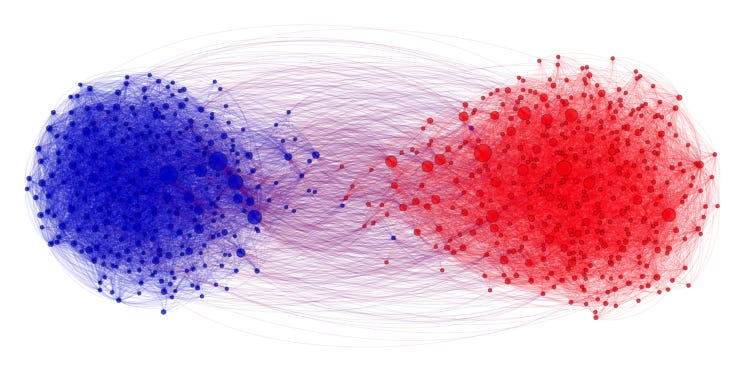

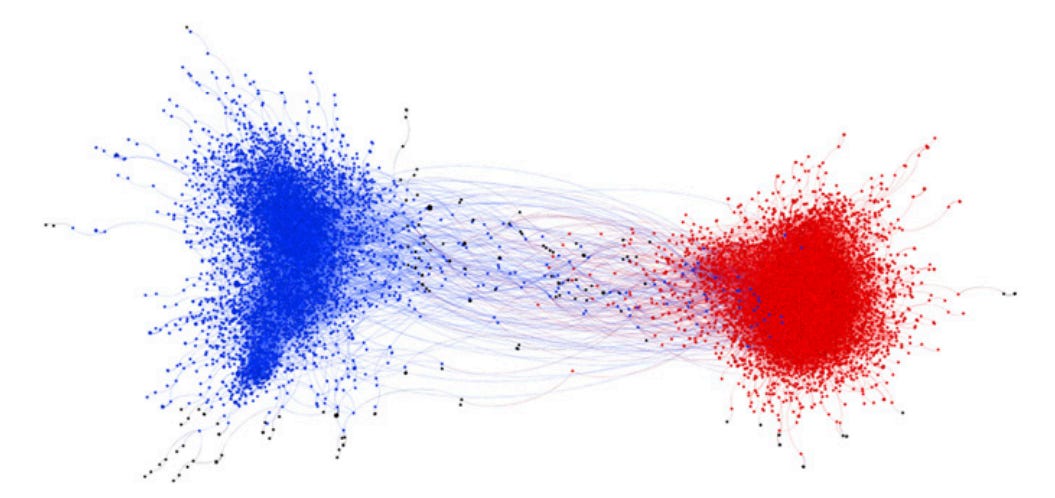
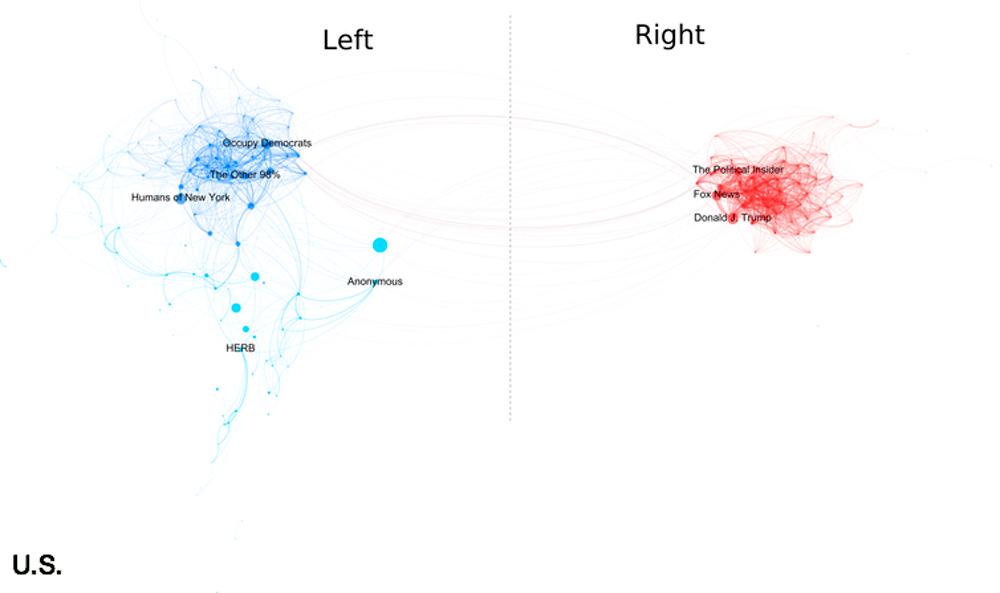
These network graphs demonstrate that, regardless of the ideological incoherence of the right – or, for that matter, the left – there very obviously are two large, and largely separate, social networks. This has remained true for at least twenty years; it’s true across different platforms; it’s true across different cultures, speaking different languages. Wherever you look, whenever you look, humans seem to naturally self-organize themselves into two ideologically opposed solitudes, densely connected internally but only weakly coupled between themselves.
When such analyses are conducted, the authors usually wring their hands about the sad state of political polarization in the contemporary world. But every time I see one of those graphs, it reminds me of this:
Bilateral symmetry is almost universal amongst the animalia1. That bilateral symmetry is reflected within the central nervous systems of all animals that possess them, most famously in the left and right hemispheres of the brain.
Importantly, while the brain hemispheres are visually symmetric, they are functionally asymmetric. Each hemisphere handles very different aspects of cognition. The hemispheres are densely connected internally but only weakly connected to one another via the narrow bridge of the corpus callosum, enabling each to work largely independently of the other, which is for the best because their cognitive modes are quite distinct and largely incompatible, as a result of which they tend not to like one another very much.
Drawing on a century of neurology research, examination of split-brain patients and patients with hemisphere-specific stroke damage, experiments with brain activity suppression using transcranial magnetic stimulation, case studies of patients with autism and schizophrenia, and numerous other lines of evidence, the psychiatrist Iain McGilchrist has advanced the hemispheric hypothesis in two books: The Master and His Emissary and his recent two-volume 1600-page magnum opus The Matter With Things. I’ve written a primer on McGilchrist’s hemisphere hypothesis (and how I think it relates to the political predicament) here:
But in the interests of this essay being self-contained, I’ll quickly2 review it here. McGilchrist’s hypothesis is that the functional asymmetry of the brain is an adaptation to a basic conundrum faced by all animal life: how to get without getting got. Animals must locate what they need in the world – food, mates, shelter – while also avoiding getting turned into food themselves. Locating resources and opportunities, and identifying threats, requires taking in all available environmental information; once an opportunity or threat has been identified, however, acquiring or avoiding it necessitates focused attention. Since broad, receptive attention and focused, intentional attention are incompatible, the most efficient way of doing both at the same time is, in effect, to have two brains: one specialized for the former, the other specialized for the latter.
Thus, the right brain observes, while the left brain obtains; the right brain comprehends, the left brain apprehends; the right brain synthesizes, the left brain analyzes; the right brain inhabits reality, while the left brain instrumentalizes it. The right brain’s purpose is to experience reality directly, without preconceptions as to what it should find there; the left brain’s modality is to use reality.
The right brain is concerned with truth, and the left brain with power.
Regardless of whether you consider yourself to be more left- or right-brained, if you reflect on it, you’ll likely notice that your own cognition switches between these modes continuously through the day. Consider the experience of sitting on the patio of a riverside cafe, watching the day go by, enjoying the warm sunshine, willow branches lazily drifting along with the cool breeze caressing your skin, people strolling down the sidewalk, birds circling overhead. You’re not trying to do anything, you’re just there, experiencing, taking it all in. Then a beautiful girl walks into your field of view. Suddenly the scenery fades into an irrelevant sepia-toned background, and all you are aware of is the sway of her hips. In the former case you’re regarding the world with the ‘soft eyes’ of the right brain, just taking it all in as a whole, without thinking about how you can use it or benefit from it; in the latter, you’re looking with the left hemisphere’s ‘hard eyes’, picking out a single extremely salient detail and focusing your attention in on it like a targeting laser. If you think about your state of mind in these two conditions, your very personality is subtly different: the one is relaxed and open, the other tense and acquisitive.
The asymmetry in function is accompanied by an asymmetry in operation. The right hemisphere is quite indiscriminate in its attention to the granular detail of reality. It notices everything, and adds it all together in order to build up as comprehensive an experience of the world as the senses allow. It does not worry about whether any given detail fits in with a pre-existing idea: if something is there, it’s there, whether it can be explained or not. It doesn’t worry about whether a given facet of reality is immediately useful. It doesn’t concern itself with how any particular phenomenon makes it feel: good or bad, threatening or pleasing, frightening or attractive, beautiful or ugly, if it’s there, it’s there, and must be acknowledged.
By contrast, the left hemisphere does not experience reality directly. Rather, it takes the right hemisphere’s presence in reality, breaks it apart into discrete elements, and ‘re-presents’ it as a simplified model, with any detail that is not of utility to the model ruthlessly and unsentimentally stripped out. The left hemisphere’s experience of the world is as an abstraction, rather than a concrete actuality. ‘Reality’ as such doesn’t really exist for the left hemisphere, only the model of reality. Since the purpose of the left hemisphere’s model is to achieve some goal – talk a pretty girl into giving you her number, say – the left hemisphere tends to ignore details that do not further the goal, as distractions (“There’s a discarded chocolate bar wrapper on the concrete next to her shoe”), or which render the goal less likely to be achievable, as demoralizations (“She’s out of your league”). The left brain tends towards an unreasonable optimism: if it decides it can do something, it can, and obstacles be damned.
Thus, while for the right hemisphere it is perfectly true that ‘facts don’t care about your feelings’, for the left hemisphere the opposite tends to be the case: qualia that aren’t useful to the model, don’t fit the model, or falsify the model, will tend to be discarded. For the right hemisphere the model is simply a cute little tool that the left hemisphere has devised; the model is itself a feature of reality, but it is not reality, and reality is primary. For the left hemisphere there is only the model, and it is quite happy to blind itself to anything which is inconvenient to it.
There’s one more functional asymmetry which is worth noting: the hemisphere’s mutual awareness. The right hemisphere is quite aware of the left hemisphere’s insights, and incorporates them into its own reality-picture as an important aspect of reality. The left hemisphere, by contrast, is only dimly aware of the right hemisphere, and considers much of the information that originates from it to be irrelevant. The right hemisphere knows that the left hemisphere is important and useful; the left hemisphere believes that it can do without the right hemisphere quite easily. This is the origin of the title of McGilchrist’s first book, The Master and His Emissary: the right brain, which understands reality, is the master; the left brain, which is effectively a tool, is the master’s emissary. The imbalance is that the left brain imagines that it is the proper master, because it is neither perceptive enough nor intelligent enough to comprehend that the restricted model-space it inhabits does not provide it with sufficient information to act independently. The left hemisphere is in a permanent state of Dunning-Kruger with respect to its dextral counterpart. It is the apprentice who thinks he can take the sorcerer’s place; left to his own devices, he immediately does so, and disaster invariably ensues.
This is what seems to happen in cases of severe right hemisphere strokes, as well as (according to McGilchrist) schizophrenia and autism. Some aspect of right hemisphere functionality is severely impaired, and the left hemisphere tries to compensate for the lack of insight into reality by developing elaborate and nonsensical models. Schizophrenia is often thought of as an absence of reason, but it is more accurately thought of as cognition in the absence of everything but reason. Schizophrenics will often develop intricate systems of thought which, viewed from the inside, are perfectly internally logically consistent, but which reach perfectly absurd conclusions either because the foundational premises are absurd, or simply because there is almost no feedback between the model and reality. Reason in the absence of anything else is frequently not at all reasonable. Indeed, it can be become quite monstrous.
Think of the left hemisphere as a computer, and the right as its user. Anyone who’s ever developed computer models will know that a program can successfully compile and return output that looks, on the face of it, quite good, but which on close inspection is nonsensical garbage. The computer itself can’t tell the difference: it’s just running the model, and whatever the model concludes is the answer. To the computer, ‘true’ is equivalent to ‘model output’. The user, however, can look at the model output, notice that the conclusion is clearly ridiculous, conclude that the model is obviously wrong, and then either discard the model or start debugging it.
I argued in Left and Right, Brains and Politics that these hemispheric distinctions map surprisingly well to the contemporary political division. The left is besotted by its abstract conceptions of reality, and indeed is almost wholly divorced from actual contact with reality: they live in a hyperreality of self-referential models, wherein it is mandatory to ignore any and all facts that are inconvenient to their ideologies. Their conception of the good is narrowly utilitarian. They are utopian, fixated upon on fixing the world and achieving paradise on Earth, and completely disinterested in anything that suggests their End of History is unachievable. They are, in practice, quite relentlessly focused upon the acquisition of political, cultural, and economic power, and absolutely disinterested in truth or beauty.
By contrast, the discourse of the political right revolves much more around truth than it does around power. That isn’t to say the right doesn’t talk about power – it does, extensively. However, this tends to be more about understanding how power works, rather than the practical concerns of acquiring and using power. In other words, the right’s power discourse is ‘what is true about power’. But then, this is only one of the subjects the right discusses, among many others. The right is also deeply concerned with history, with current events, with human biology, with religion ... and in every case, the primary imperative is gathering and parsing information in an effort to understand what is true about each subject individually, and therefore about the world more generally. The right is completely insensitive to how any given fact makes someone feel: it does not care if racial IQ statistics or the male variability hypothesis or whatever gives you the sads, all that matters is whether or not it is true. Furthermore, the right’s worldview, broadly conceived, is deeply organic: contemporary politics cannot be understood in isolation from human sociobiology, history, geography, technology, nor can any of those other subjects be understood in isolation from the others. Right-wing discourse tends to be an exploratory interdisciplinary synthesis, drawing together strands from multiple aspects of human experience and weaving them together to reach tentative, open-ended conclusions, inevitably responded to with a “Yes, but....”
Note the incredibly different emotional tenor of discourse within the left and the right. On the left, it is tense and paranoid: one is constantly at risk of cancellation for saying or noticing something that violates one of the left’s many elaborate models. On the right, it is open and playful: as savage and juvenile as the right can be, it is all in good fun, and it is practically impossible to get cancelled. The left reacts with rage when one of its models is challenged; the right with a grin and a shrug.
Note also how the left tends towards mania, throwing their energy behind this cause or that, whereas the right is permeated by a historical pessimism against which it struggles to maintain its morale. For the left, history has an arc and utopia is just around the corner; for the right, history is a cyclical wave, against which struggle is as futile as resisting the changing seasons. Mania is a characteristically left-hemisphere psychological illness; right-hemisphere over-activation, conversely, tends to result in clinical depression.
It is probably no accident that the left has always shown such a great affinity for managerialism, technocracy, and bureaucracy. Those heavily systematized organs of societal control are deeply left hemisphere in character. They reduce the world to standardized mechanical procedure, and thereby render it more easily controlled. Conversely, it is no coincidence that the right has tended more towards romanticism, emphasizing the personal touch, the full richness of human experience, the role in history played by great men, the centrality of the human spirit.
Aesthetically, the left strongly prefers the abstract form. Their architecture is blunt, boxy, shorn of adornment. The right has almost always gravitated more towards the organic, the baroque, the pastoral, the representational. The right prefers architecture that is beautiful as well as being functional; the left, by and large, sees beauty as a confusingly pointless spandrell.
I do not think it is necessarily a mere metaphor to suggest that network graphs showing the online population separated into two polarized ‘echo chambers’ is an analogue to the hemispheric organization of the animal brain. After all, the Internet was created and is inhabited by beings with lateralized cognitive asymmetry. While any given human (who has not suffered severe brain damage) utilizes both hemispheres in practice, most will have a tendency to rely more on one or the other. Those differences are very slight, but small differences at the individual level can, at the level of large populations, produce dramatic effects. In the hyper-connectivity of the Internet age, it would be only natural to expect that two groups – those with a slight tendency to rely on their right hemisphere, and those tending towards the left – would self-organize into distinct groups. Indeed there’s no reason to think this phenomenon is unique to the information age, and a review of history shows that factionalization along lines that might broadly be conceived of as left and right goes back a very long time (for example, the Tories and Whigs of England; the optimates and populares of Rome; the aristocratic and democratic factions of ancient Greece): the only difference now is that we have data and the tools to visualize it.
So if there’s anything to this framing of the political predicament, what are the implications?
First, polarization per se is not a problem. In fact, it’s probably adaptive. Too much connectivity between the hemispheres prevents each from serving its proper function. They need to do their work largely in isolation. What is true at the human microcosm, is also true for the social macrocosm. Having separate groups of humans focused on understanding reality vs. changing reality is actually quite a sensible way to organize ourselves.
However, that doesn’t mean there is no problem. There obviously is. Society, as we can all see, has gone insane. As the recent video from Christopher F. Rufo
argues, we live in a Cluster B Society, which is another word for the pathocracy that Harrison Koehli has made it his mission to describe and analyze at his Political Ponerology blog (there’s also a book, by the way). Depression, anxiety, and narcissism have reached epidemic proportions. Many are lost in hopeless despondency; many others are under intense psychic stress, a continuous state of manic arousal and free-floating anger. Our society is dominated by the deranged, and as a result, it produces derangement.
Much of this problem comes down to the left – proximately the ideological left, but more fundamentally the left hemisphere – having taken charge. The emissary has usurped the role of the master. Seeing only what she wants to see, the emissary is operating in total isolation from reality, and as such her interventions grow increasingly catastrophic. The emissary is not capable of meaningful self-correction: the reality she inhabits is composed entirely of models, and while she can elaborate those models when they fail to produce the desired results, she is not psychologically equipped to abandon her treasured models. Disastrous failure isn’t evidence that the goal is unreachable, merely that insufficient effort has been applied. Tweak the model a bit, and push on. It isn’t that feminism was a terrible idea, it’s that we weren’t feminist enough. It’s not that there are meaningful differences between the races, it’s that hidden structural racism has stymied us; what we need is more affirmative action, and maybe a Department of Antiracism. The mountains of skulls and oceans of miserable hunger just mean that Real Communism Has Never Been Tried.
Balance needs to be restored: the master must return to his proper place. This does not mean, I think, that the left must be utterly defeated and even extirpated. This almost certainly isn’t possible: insofar as the ideological left arises from left-hemisphere cognition, it will always be with us. Rather, the left must be returned to its proper, subordinate role in society. There are occasions when reform is necessary. Sometimes one of Chesterton’s fences really does need to be knocked down, and the left is just the wrecking crew to do it; the problem isn’t knocking down fences per se, but allowing the left to decide which fences to dismantle (their answer will inevitably be: all of them).
So how do we restore balance? The short answer is, I don’t really know. Part of the problem is that the managerial systems knitting together our society suppress right-hemisphere thinking. There’s a positive feedback loop between industrial society and the left: the more mechanized our society becomes, the more it encourages reliance on the left hemisphere, and therefore the more leftist it becomes. The psychosis feeds on itself. Another, related part of the problem is that the power orientation of the left means, tautologically, that it will always seek to expand its power, by its very nature; whereas the truth orientation of the right means that it is naturally disinclined to do so.
Yet somehow, reality must be made to reassert itself within the reality-models of the left. What would it look like, if the left was made to accept that human biodiversity is both real and a significant source of divergent socioeconomic outcomes; that a high degree of ethnic heterogeneity is almost invariably a source of societal conflict and decay; that behavioural differences between the sexes are intractable and inevitable, but also necessary and desirable; that men are not women, cannot be made so with drugs and surgery, and attempting to do so is a sadistic abomination; that carbon dioxide is not the primary driver of the climate, and that the human impact on climate is quite minor in comparison to cosmic influences? In other words, what would the left become, if it incorporated all of the right’s most well-tested truth-propositions? How would its models change? The left certainly wouldn’t disappear. There would still be people concerned with making society more fair, more just, and more equitable, with achieving ‘progress’ in terms of technological and societal improvement. Finding problems in the world and fixing them is deeply human. We can’t stop ourselves from monkeying about with things. But that monkeying is much more likely to be successful if it is based in reality.
I opened this essay with the subject of NETTR. The main implication of this model for NETTR is that it is, in my opinion, at this point something of a non-problem. It is in the right’s nature to vigorously debate ideas, but it is not in the right’s nature to cancel; the worst that the right tends to do to its own is that someone gets ignored if they keep talking obvious nonsense by clinging to clearly established falsehoods. The modern right defies any attempt to define it according to a simplistic, uniaxial typology: determining who is to the right of whom is not at all straightforward, and frequently reverses itself based on perspective (is the Tradcath to the right of the Vitalist, or vice-versa? Each will give a different answer). Instead, people in right-wing spaces should simply ask if someone seems to be engaged in a genuine search for the truth; if so, that’s good enough to treat them with civility, even if you don’t agree with everything they say. And as for those who mewl that something cannot be thought or said because it is ‘immoral’ according to left-wing reality models? Well ... they’re obviously not part of the right-wing cognitive network at all, in any meaningful sense, so there’s no particular reason to be civil to them.
Far more pressing is the question of what to do about the left. Is it possible to reach them, by packaging ideas in sufficiently compelling memes, narratives, arguments, and the like? Perhaps for some, it is; and indeed, the growth of the right’s cultural influence over the last few years, as it has pursued precisely this strategy, suggests that this is slowly working. Will that be enough? Or will society require the equivalent of a nervous breakdown: a hard reset, pulling the plug and rebooting? Something like a military coup, or even a civil war, removing the left from institutional power by force in order to restore the appropriate balance? That probably can’t be ruled out, either. Sticking with the neurological metaphor, if the origin of the psychosis is a brain tumour, then the tumour must be cut out; if it is a brain parasite, the parasite must be cleansed from the system. Perhaps it is a drug, in which case the answer is simply to stop ingesting the poison. But perhaps the cause was a stoke, in which case the remedy is for the remaining undamaged tissues to gradually, and with great effort, reconfigure themselves to perform the impaired functions.
Or maybe our collective nervous system has simply gone haywire, on its own, and restoring balance is easier than we think. On a personal level, when your left hemisphere has gotten out of whack, the best remedies are often quite straightforward. Go for an aimless ramble in nature. Get into your body. Relax. Stop trying to do, and just be. Pray and meditate. Talk with others, not to argue or debate, but just to converse with them, laugh with them. Analogizing to the societal scale: pull back from the virtual world, touch grass, embrace embodiment, reacquaint ourselves with the natural and the real and the sacred. We can’t force others to follow such an example, but the more people who engage in such practices, the stronger the signal becomes within the shared human consciousness.
But maybe the hemispheric metaphor is completely mistaken, and the better analogy to this
Is this
In which case, the only thing we can do is follow the process of mitosis to its logical conclusion, and separate into distinct social organisms.
There are a few exceptions, but these tend to be colony organisms (jellyfish, sponges), or (in the case of the echinoderms such as starfish and sea urchins) evolved from organisms with bilateral symmetry. In fact, free-swimming larval sea urchins have bilateral symmetry, with pentalateral symmetry only emerging in the sessile adult form.
LOL
Source: Postcards From Barsoom


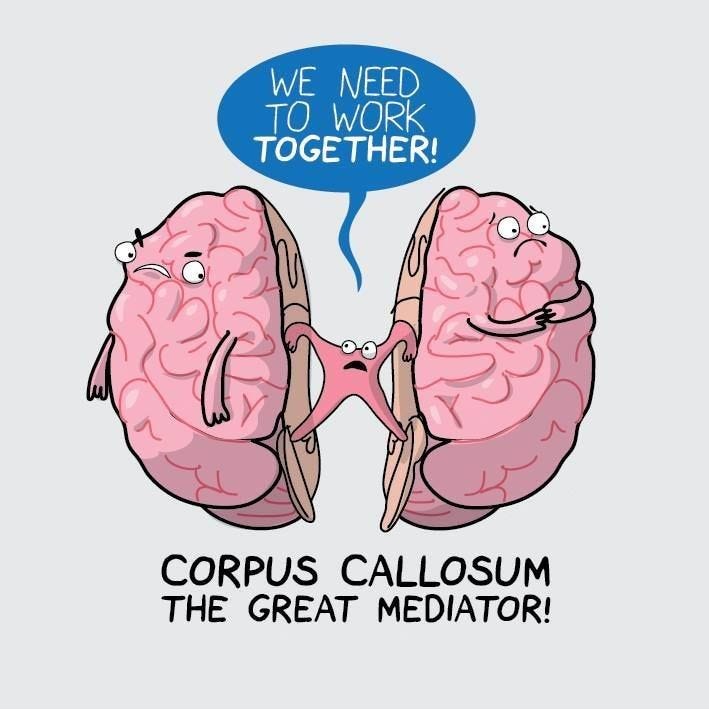

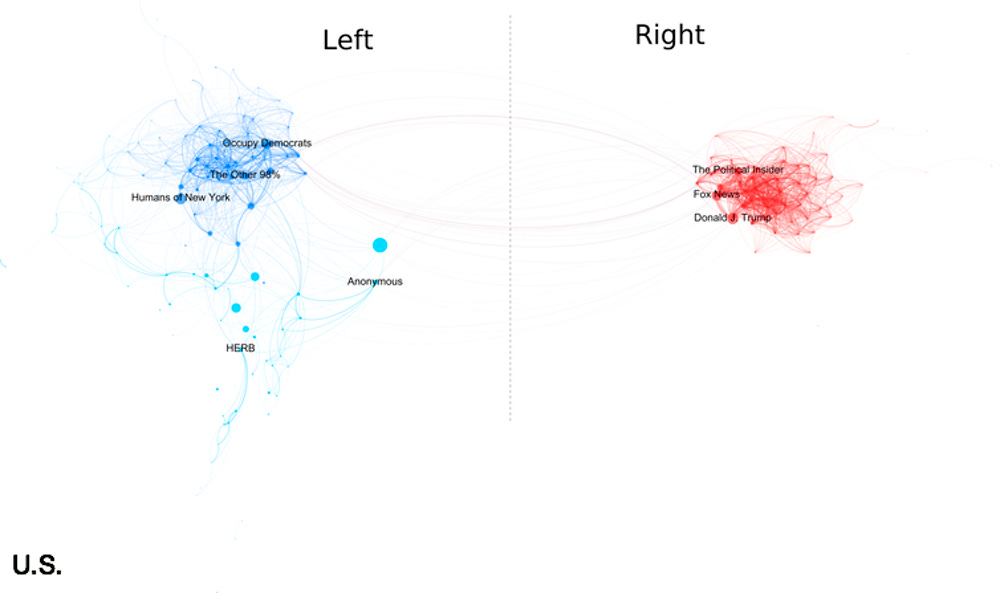

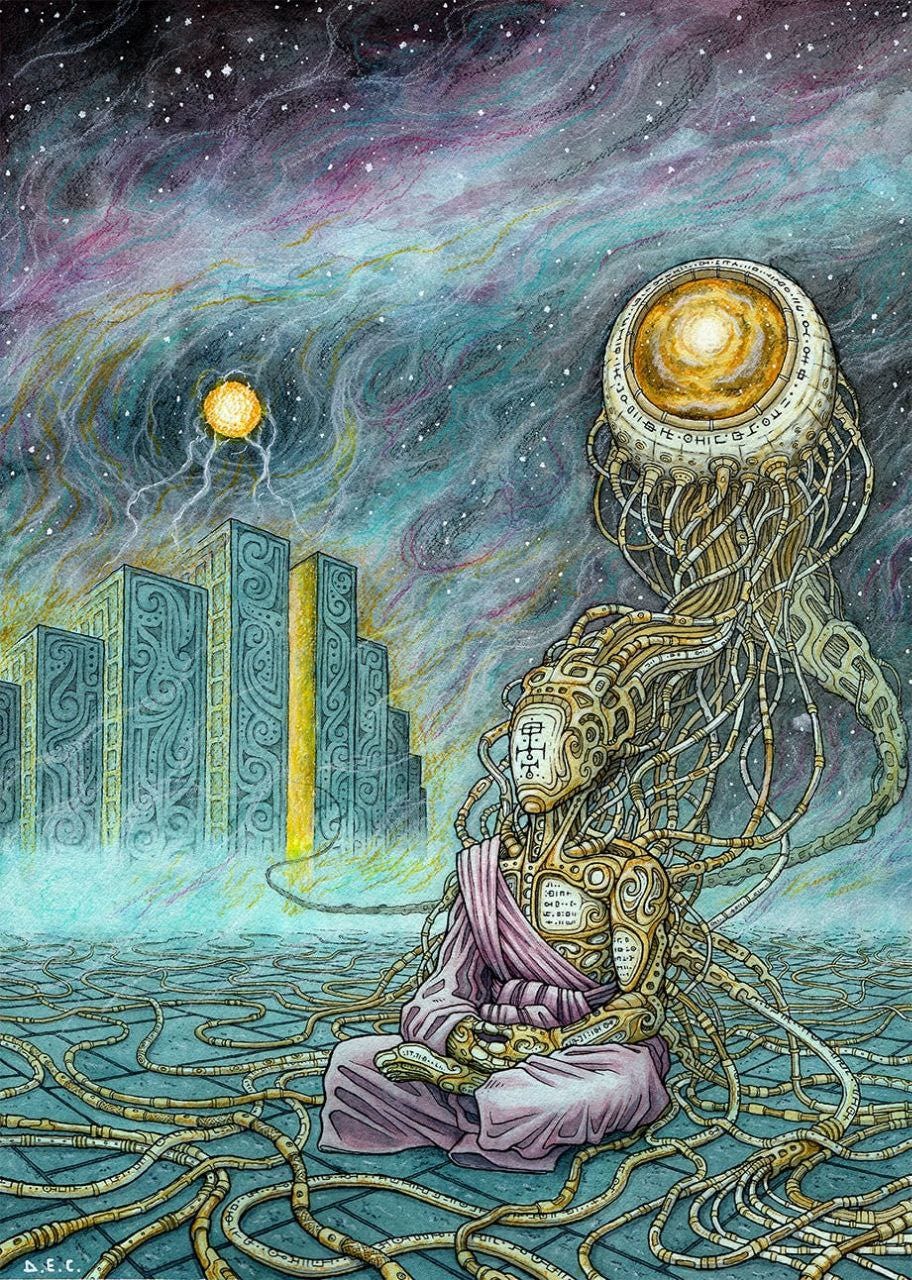
Comments
Post a Comment